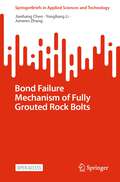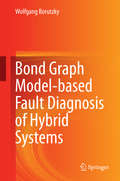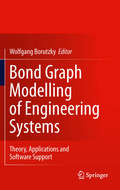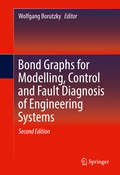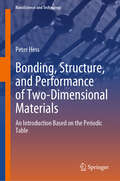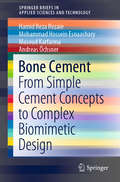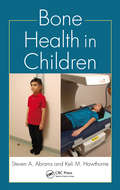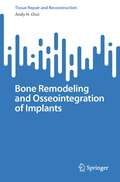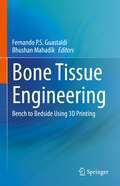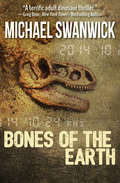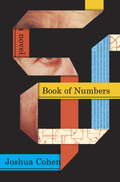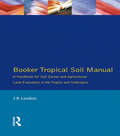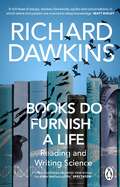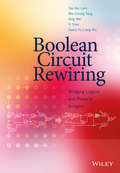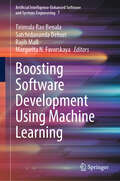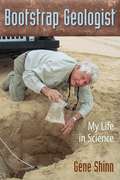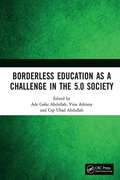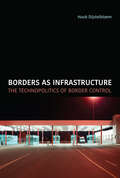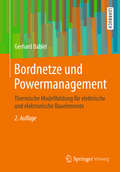- Table View
- List View
Bonanza Girl
by Patricia BeattyA widow and her two children head for gold rush territory in Idaho, hoping to find jobs and a new life.
Bond Failure Mechanism of Fully Grouted Rock Bolts (SpringerBriefs in Applied Sciences and Technology)
by Junwen Zhang Jianhang Chen Yongliang LiThe purpose of writing this book is to provide the latest research findings in ground control techniques in mining engineering, especially the rock bolting techniques. Since rock bolts are widely used in mining engineering and civil engineering, they are significant in guaranteeing the safety of underground openings. However, instability issues still occur with the rock bolting technique. Therefore, it is valuable to understand the exact load transfer mechanism of rock bolts. This book summarised the recent research work regarding rock bolting conducted by the authors. It is valuable for the readers to fully understand the reinforcing mechanism of fully grouted rock bolts. This book focuses on the bond failure mode of fully grouted rock bolts, which is the most widely encountered failure mode in rock bolting. Different investigation approaches are used in this book, including numerical simulation, analytical modelling and experimental tests. Therefore, this book conducts a comprehensive study to reveal the bond failure process of fully grouted rock bolts. Moreover, it reveals the corresponding bond failure mechanism. Therefore, it helps the reads to fully understand the bond failure mechanism of rock bolting. Moreover, it helps the readers to develop new approaches and methods to prevent failure of the rock bolting system.This is an open access book.
Bond Graph Model-based Fault Diagnosis of Hybrid Systems
by Wolfgang BorutzkyThis book presents bond graph model-based fault detection with a focus on hybrid system models. The book addresses model design, simulation, control and model-based fault diagnosis of multidisciplinary engineering systems. The text beings with a brief survey of the state-of-the-art, then focuses on hybrid systems. The author then uses different bond graph approaches throughout the text and provides case studies.
Bond Graph Modelling for Control, Fault Diagnosis and Failure Prognosis
by Wolfgang BorutzkyThis book shows in a comprehensive presentation how Bond Graph methodology can support model-based control, model-based fault diagnosis, fault accommodation, and failure prognosis by reviewing the state-of-the-art, presenting a hybrid integrated approach to Bond Graph model-based fault diagnosis and failure prognosis, and by providing a review of software that can be used for these tasks.The structured text illustrates on numerous small examples how the computational structure superimposed on an acausal bond graph can be exploited to check for control properties such as structural observability and control lability, perform parameter estimation and fault detection and isolation, provide discrete values of an unknown degradation trend at sample points, and develop an inverse model for fault accommodation. The comprehensive presentation also covers failure prognosis based on continuous state estimation by means of filters or time series forecasting. This book has been written for students specializing in the overlap of engineering and computer science as well as for researchers, and for engineers in industry working with modelling, simulation, control, fault diagnosis, and failure prognosis in various application fields and who might be interested to see how bond graph modelling can support their work.Presents a hybrid model-based, data-driven approach to failure prognosisHighlights synergies and relations between fault diagnosis and failure prognosticDiscusses the importance of fault diagnosis and failure prognostic in various fields
Bond Graph Modelling of Engineering Systems: Theory, Applications and Software Support
by Wolfgang BorutzkyThe author presents current work in bond graph methodology by providing a compilation of contributions from experts across the world that covers theoretical topics, applications in various areas as well as software for bond graph modeling. It addresses readers in academia and in industry concerned with the analysis of multidisciplinary engineering systems or control system design who are interested to see how latest developments in bond graph methodology with regard to theory and applications can serve their needs in their engineering fields. This presentation of advanced work in bond graph modeling presents the leading edge of research in this field. It is hoped that it stimulates new ideas with regard to further progress in theory and in applications.
Bond Graphs for Modelling, Control and Fault Diagnosis of Engineering Systems
by Wolfgang BorutzkyThis book presents theory and latest application work in Bond Graph methodology with a focus on: * Hybrid dynamical system models, * Model-based fault diagnosis, model-based fault tolerant control, fault prognosis * and also addresses * Open thermodynamic systems with compressible fluid flow, * Distributed parameter models of mechanical subsystems. In addition, the book covers various applications of current interest ranging from motorised wheelchairs, in-vivo surgery robots, walking machines to wind-turbines. The up-to-date presentation has been made possible by experts who are active members of the worldwide bond graph modelling community. This book is the completely revised 2nd edition of the 2011 Springer compilation text titled Bond Graph Modelling of Engineering Systems - Theory, Applications and Software Support. It extends the presentation of theory and applications of graph methodology by new developments and latest research results. Like the first edition, this book addresses readers in academia as well as practitioners in industry and invites experts in related fields to consider the potential and the state-of-the-art of bond graph modelling.
Bonding, Structure, and Performance of Two-Dimensional Materials: An Introduction Based on the Periodic Table (NanoScience and Technology)
by Peter HessThis book presents a wealth of results obtained by first-principles calculations, molecular dynamics simulations, and tight-binding modeling on two-dimensional covalent bonding and the resulting formation of 2D materials. It focuses on the bonding–structure relationships derived from the periodicity of the electron configuration and atomic size, paying particular attention to the overall stability of various elemental and composite networks. In addition to accurate first-principles calculations, the book uses a linear combination of atomic orbitals and the hybridization concept to gain deep insight into the rules governing the world of 2D chemistry. Of special interest are the novel properties of 2D materials based on quantum confinement effects in two dimensions and the large surface-to-volume ratio. The book gives an introduction to the fundamental principles of 2D structure formation for newcomers in this field, simultaneously providing a comprehensive source of data on bonding strength, geometrical structure, and nanomechanics characterizing the manifold of chemical networks in two-dimensional space. This book is a valuable reference for material scientists, chemists, and any researcher in the field of 2D materials and low-dimensional nanoscience.
Bone Cement: From Simple Cement Concepts to Complex Biomimetic Design (SpringerBriefs in Applied Sciences and Technology)
by Andreas Öchsner Hamid Reza Rezaie Mohammad Hossein Esnaashary Masoud KarfarmaThis book provides an overview of the composition of polymeric and ceramic bone cements. It also discusses complex, biomimetic structures based on biomaterials, such as cells and bioactive molecules, which more closely resemble natural bone The first chapter describes the main concepts of the cementation process and the parameters affecting it, while the second chapter focuses on the composition and structure of candidate biomaterials. Lastly, the third and fourth chapters present recent research aimed at improving the ability of naked biomaterials to enhance bone healing by adding cells and bioactive agents.
Bone Health in Children
by Steven A. Abrams Keli M. HawthorneBone health is one of the most widely discussed topics in pediatric nutrition. Ensuring adequate calcium and vitamin D intake is essential, and other factors also play a significant role. Bone Health in Children explores the recent decades of research and public commentary on the subject, debunks popular myths, and clarifies the often confusing and
Bone Quantitative Ultrasound: New Horizons (Advances in Experimental Medicine and Biology #1364)
by Pascal Laugier Quentin GrimalMany significant achievements in new ultrasound technologies to measure bone and models to elucidate the interaction and the propagation of ultrasonic waves in complex bone structures have been reported over the past ten years. Impaired bone remodeling affects not only the trabecular compartment but also the cortical one. Despite the crucial contribution of the cortical structure to the whole bone mechanical competence, cortical bone was understudied for a long time. A paradigm shift occurred around 2010, with a special focus placed on the importance of cortical bone. This has sparkled a great deal of interest in new ultrasound techniques to assess cortical bone. While our book ‘Bone Quantitative Ultrasound’ published in 2011 emphasized techniques to measure trabecular bone, this new book is devoted for a large part to the technologies introduced recently to measure cortical bone. These include resonant ultrasound spectroscopy, guided waves, scattering, and pulse-echo and tomography imaging techniques. Instrumentation, signal processing techniques and models used are detailed. Importantly, the data accumulated in recent years such as anisotropic stiffness, elastic engineering moduli, compression and shear wave speeds of cortical bones from various skeletal sites are presented comprehensively. A few chapters deal with the recent developments achieved in quantitative ultrasound of trabecular bone. These include (i) scattering-based approaches and their application to measure skeletal sites such as the spine and proximal femur and (ii) approaches exploiting the poro-elastic nature of bone. While bone fragility and osteoporosis are still the main motivation for developing bone QUS, this Book also includes chapters reporting ultrasound techniques developed for other applications of high interest such as 3-D imaging of the spine, assessment of implant stability and transcranial brain imaging. This book, together with the book ‘Bone Quantitative Ultrasound’ published in 2011 will provide a comprehensive overview of the methods and principles used in bone quantitative ultrasound and will be a benchmark for all novice or experienced researchers in the field. The book will offer recent experimental results and theoretical concepts developed so far and would be intended for researchers, graduate or undergraduate students, engineers, and clinicians who are involved in the field. The book should be considered as a complement to the first book publisher in 2011, rather than a second edition, in the sense that basic notions already presented in the first book are not repeated.
Bone Remodeling and Osseointegration of Implants (Tissue Repair and Reconstruction)
by Andy H. ChoiThis book provides an insight into the latest advances in bone fracture healing and remodeling algorithm and their incorporation into patient-specific finite element models and the use of machine learning and artificial intelligence to predict the bone regeneration and osseointegration process with a certain degree of accuracy. It also examines the applications of numerical models to simulate the fracture healing process, which may prove to be advantageous in determining the optimal mechanical-based treatment or reconstruction after an accident or illness. This book is aimed at medical and dental professionals who are involved in implantology and tissue engineering such as dentists, oral and maxillofacial surgeons, orthopedic surgeons, students, and researchers.
Bone Tissue Engineering: Bench to Bedside Using 3D Printing
by Fernando P. S. Guastaldi Bhushan MahadikThis book provides a comprehensive overview of the state-of-the-art research as well as current challenges and strategies to reconstruct large bone defects employing 3D printing technology. Various topics covered include different 3D printing technologies that can be applied for bioengineering bone, the aspects of basic bone biology critical for clinical translation, tissue engineering platforms to investigate the bone niche microenvironment, the pathway to clinical translation, and regulatory hurdles.Bone Tissue Engineering: State-of-the-Art in 3D Printing is an ideal book for students and researchers interested in learning more about the latest advances in employing different 3D printing technologies for bone tissue engineering.
Bones of the Earth: Three Science Fiction Thrillers
by Michael SwanwickModern technology is pitted against ancient dinosaurs in this scientific thriller James Rollins calls &“Jurassic Park set amid the paradox of time travel.&” Paleontologist Richard Leyster is perfectly content in his position with the Smithsonian excavating dinosaur fossil sites and publishing his findings . . . until the mysterious Harry Griffin appears in his office with a cooler containing the head of a freshly killed Stegosaurus. The enigmatic stranger offers Leyster the opportunity to travel back in time to study living dinosaurs in their original habitats—but with strings attached. Soon, the paleontologist finds himself, along with a select team of colleagues—including his chief rival, the ambitious and often ruthless Dr. Gertrude Salley—making discoveries that would prove impossible working from fossils alone. But when Leyster and his team are stranded in the Cretaceous, they must learn to survive while still keeping alive the joy of scientific discovery. This shocking novel spans hundreds of millions of years and deals with the ultimate fate not only of the dinosaurs but also of all humankind. Nominated for the Locus Award, the Hugo Award, and the Nebula Award for Best Novel, Bones of the Earth cements author Michael Swanwick as an author who &“proves that sci-fi has plenty of room for wonder and literary values&” (San Francisco Chronicle).
Bonneville 928: Land Speed Racing in a Porsche 928
by Carl FausettBonneville 928 is a must read for any car enthusiast. Within, Carl Fausett chronicles his journey of taking a modified German performance car to the most American of events; the Bonneville land speed record race. Fausett masterfully portrays the unique challenges of adapting a street car to a land speed record spec, a standard that is basically peerless in the motorsports world. Through simple, heartfelt storytelling, we take the journey alongside Fausett and experience his highs and lows as he attempts to capture the land speed record in his class. Bonneville 928 is a worthy read for anyone who loves to modify cars; Fausett, in his characteristics down to earth fashion pulls no punches and tells you everything that worked and didn't work with his car, giving the reader valuable insights into what it takers to go fast. This book is also written with the common car enthusiast in mind, and Fausett builds the car on a limited budget, unlike many of his competitors. It's a real David vs Goliath tale about a normal guy with a gutsy crew and an ambitious dream. If you like Porsche 928s, and you've ever wondered how the car stacks up against the world's best, this book is for you.
Book of Numbers
by Joshua CohenA monumental, uproarious, and exuberant novel about the search--for love, truth, and the meaning of Life With The Internet. The enigmatic billionaire founder of Tetration, the world's most powerful tech company, hires a failed novelist, Josh Cohen, to ghostwrite his memoirs. The mogul, known as Principal, brings Josh behind the digital veil, tracing the rise of Tetration, which started in the earliest days of the Internet by revolutionizing the search engine before venturing into smartphones, computers, and the surveillance of American citizens. Principal takes Josh on a mind-bending world tour from Palo Alto to Dubai and beyond, initiating him into the secret pretext of the autobiography project and the life-or-death stakes that surround its publication. Insider tech exposé, leaked memoir-in-progress, international thriller, family drama, sex comedy, and biblical allegory, Book of Numbers renders the full range of modern experience both online and off. Embodying the Internet in its language, it finds the humanity underlying the virtual. Featuring one of the most unforgettable characters in contemporary fiction, Book of Numbers is an epic of the digital age, a triumph of a new generation of writers, and one of those rare books that renew the idea of what a novel can do. Please note that Book of Numbers uses a special pagination system inspired by binary notation: the part number precedes the page number, and is separated from it by a decimal point. Praise for Book of Numbers "Joshua Cohen is the Great American Novelist. . . . Like Pynchon and Wallace, Cohen can write with tireless virtuosity about absolutely everything. . . . Cohen has turned the tables on the Internet: Instead of being reduced by its omniscience, he forces it to serve his imaginative purposes. . . . If John Henry is going to compete with the steam engine, he needs an almost superhuman energy and intelligence of his own--and if any writer has it, it is Joshua Cohen."--Adam Kirsch, Tablet "The next candidate for the Great American Novel . . . David Foster Wallace-level audacious."--Details "[A] monstrous talent and restive, roiling intellect . . . Other recent literary novels have treated the dot-com-mania reboot, its flagship companies, and their 'disruptive' technologies--Pynchon's Bleeding Edge, Dave Eggers's The Circle--but Cohen's is the best."--Bookforum "Cohen returns with a new novel questioning what life is in the digital age. The prolific writer . . . has given us a smart thriller to kick off the season. . . . Inspiring in a way that requires readers to pay attention not just to the words but the book as a form."--Vanity Fair "Reading Cohen's magnum opus is a lot like falling down an Internet wormhole. In Numbers, you'll find an international mystery, a fake memoir, a modern retelling of the biblical Book of Numbers, a sex romp, and a bunch of leaked documents. Think David Foster Wallace meets David Mitchell meets the search history that you just cleared. Beast."--Esquire"An ambitious and inspired attempt at the Great American Internet Novel . . . Cohen's encyclopedic epic is about many things--language, art, divinity, narrative, desire, global politics, surveillance, consumerism, genealogy--but it is above all a standout novel about the Internet."--Publishers Weekly (starred review)From the Hardcover edition.
Booker Tropical Soil Manual: A Handbook for Soil Survey and Agricultural Land Evaluation in the Tropics and Subtropics
by J.R. LandonFirst published in 1991. This is a more portable version of the Booker Tropical Soil Manual, in which the format (and weight) of the first edition have been reduced whilst retaining as much as possible of the original clarity. It also includes new content and appendices that cover the revised FAO publications on soil classification and on water quality for agriculture.
Books do Furnish a Life: An electrifying celebration of science writing
by Richard Dawkins'A rich feast of his essays, reviews, forewords, squibs and conversations, in which talent and passion are married to deep knowledge.' Matt Ridley'Enjoy the unfailing clarity of his thought and prose, as well as the grandeur of his vision of life on Earth.' - Mark Cocker, Spectator'Richard Dawkins is a thunderously gifted science writer.' Sunday TimesIncluding conversations with Neil DeGrasse Tyson, Steven Pinker, Matt Ridley and more, this is an essential guide to the most exciting ideas of our time and their proponents from our most brilliant science communicator.Books Do Furnish a Life is divided by theme, including celebrating nature, exploring humanity, and interrogating faith. For the first time, it brings together Richard Dawkins' forewords, afterwords and introductions to the work of some of the leading thinkers of our age - Carl Sagan, Lawrence Krauss, Jacob Bronowski, Lewis Wolpert - with a selection of his reviews to provide an electrifying celebration of science writing, both fiction and non-fiction. It is also a sparkling addition to Dawkins' own remarkable canon of work.Plenty of other scientists write well, but no one writes like Dawkins... here is Dawkins the teacher, the scholar, the polemicist, the joker, the aesthete, the poet, the satirist, the man of compassion as well as indignation, the slayer of superstition and, above all, the scientist. - Areo Magazine
Boolean Circuit Rewiring: Bridging Logical and Physical Designs
by Xing Wei Tak-Kei Lam Wai-Chung Tang Yi Diao David Yu-Liang WuDemonstrates techniques which will allow rewiring rates of over 95%, enabling adoption of deep sub-micron chips for industrial applications Logic synthesis is an essential part of the modern digital IC design process in semi-conductor industry. This book discusses a logic synthesis technique called “rewiring” and its latest technical advancement in term of rewirability. Rewiring technique has surfaced in academic research since 1993 and there is currently no book available on the market which systematically and comprehensively discusses this rewiring technology. The authors cover logic transformation techniques with concentration on rewiring. For many decades, the effect of wiring on logic structures has been ignored due to an ideal view of wires and their negligible role in the circuit performance. However in today’s semiconductor technology wiring is the major player in circuit performance degeneration and logic synthesis engines can be improved to deal with this through wire-based transformations. This book introduces the automatic test pattern generation (ATPG)-based rewiring techniques, which are recently active in the realm of logic synthesis/verification of VLSI/SOC designs. Unique comprehensive coverage of semiconductor rewiring techniques written by leading researchers in the field Provides complete coverage of rewiring from an introductory to intermediate level Rewiring is explained as a flexible technique for Boolean logic synthesis, introducing the concept of Boolean circuit transformation and testing, with examples Readers can directly apply the described techniques to real-world VLSI design issues Focuses on the automatic test pattern generation (ATPG) based rewiring methods although some non-ATPG based rewiring methods such as graph based alternative wiring (GBAW), and “set of pairs of functions to be distinguished” (SPFD) based rewiring are also discussed A valuable resource for researchers and postgraduate students in VLSI and SoC design, as well as digital design engineers, EDA software developers, and design automation experts that specialize in the synthesis and optimization of logical circuits.
Boom-Bust Cycle, Asymmetrical Fiscal Response and the Dutch Disease
by Kareem Ismail Rabah ArezkiA report from the International Monetary Fund.
Boosting Software Development Using Machine Learning (Artificial Intelligence-Enhanced Software and Systems Engineering #7)
by Satchidananda Dehuri Margarita N. Favorskaya Rajib Mall Tirimula Rao BenalaThis book explores the transformative effects of AI and ML on software engineering. It emphasizes the potential of cutting-edge software development technologies such as Generative AI and ML applications. This book incorporates data-driven strategies across the entire software development life cycle, from requirements elicitation and design to coding, testing, and deployment. It illustrates the evolution from traditional frameworks to agile and DevOps methodologies. The potential of Generative AI for automating repetitive tasks and enhancing code quality is highlighted, along with ML applications in optimizing testing, effort estimation, design pattern recognition, fault prediction, debugging, and security through anomaly detection. These techniques have significantly improved software development efficiency, predictability, and project management effectiveness. While remarkable progress has been made, much remains to be done in this evolving area. This edited book is a timely effort toward advancing the field and promoting interdisciplinary collaboration in addressing ethical, security, and technical challenges.
Bootstrap Geologist: My Life in Science
by Gene ShinnIn Bootstrap Geologist Shinn enthusiastically shares the highs and lows of his remarkable life. Taking readers around the globe as well as below the ocean, he recounts the painstaking process of data gathering that can lead to paradigm-breaking discoveries. He emphasizes the importance of field science and pointedly addresses the use and abuse of scientific research and the emergence of market-funded research.
Borate Phosphors: Processing to Applications
by S. K. OmanwarBorate-based phosphors have attracted much attention, due to their high optical stability, low-cost synthesis via conventional and non-conventional methods and resulting technology to be environmentally friendly. This book discusses the structural and chemical parameters of borates as a phosphor including suitable synthesis methods and proper characterization of materials. Further, it includes applications of borate materials such as photoluminescence, UV application, UVU application, photo therapy application and radiological applications. Features: Provides information on borate phosphors and their structure. Aids selection of proper structural and functional borates used in applications based on phosphor technology. Discloses the modification in properties of borate functional group upon mixing or substitution with other metallic functional groups. Discusses biological applications such as photo-thermal heating-based therapy, temperature sensors, imaging, and diagnosis. Includes current trends and innovations, limitations and challenges, prospects, and scope in each chapter. This book is aimed at researchers and graduate students in inorganic materials, luminescent/optical materials, materials science/engineering, and physics.
Borderless Education as a Challenge in the 5.0 Society: Proceedings of the 3rd International Conference on Educational Sciences (ICES 2019), November 7, 2019, Bandung, Indonesia
by Ade Gafar AbdullahThese proceedings contain a selection of papers presented at the 3rd International Conference on Educational Sciences, organized on 16 November 2019. It covers themes such as philosophy and policy of teacher education; curriculum, teaching and learning approaches; learner’s characteristics in the digital era; global citizenship education; vocational education; teacher education qualification framework; management, supervision and assessment; lifelong learning for all; diversity in education; equality of educational opportunity; vocational and entrepreneurship education; and education in the industry 4.0 era.
Borders as Infrastructure: The Technopolitics of Border Control (Infrastructures)
by Huub DijstelbloemAn investigation of borders as moving entities that influence our notions of territory, authority, sovereignty, and jurisdiction.In Borders as Infrastructure, Huub Dijstelbloem brings science and technology studies, as well as the philosophy of technology, to the study of borders and international human mobility. Taking Europe's borders as a point of departure, he shows how borders can transform and multiply and and how they can mark conflicts over international orders. Borders themselves are moving entities, he claims, and with them travel our notions of territory, authority, sovereignty, and jurisdiction. The philosophies of Bruno Latour and Peter Sloterdijk provide a framework for Dijstelbloem's discussion of the material and morphological nature of borders and border politics.Dijstelbloem offers detailed empirical investigations that focus on the so-called migrant crisis of 2014-2016 on the Greek Aegean Islands of Chios and Lesbos; the Europe surveillance system Eurosur; border patrols at sea; the rise of hotspots and "humanitarian borders"; the technopolitics of border control at Schiphol International Airport; and the countersurveillance by NGOs, activists, and artists who investigate infrastructural border violence. Throughout, Dijstelbloem explores technologies used in border control, including cameras, databases, fingerprinting, visual representations, fences, walls, and monitoring instruments. Borders can turn places, routes, and territories into "zones of death." Dijstelbloem concludes that Europe's current relationship with borders renders borders--and Europe itself--an "extreme infrastructure" obsessed with boundaries and limits.
Bordnetze und Powermanagement: Thermische Modellbildung Für Elektrische Und Elektronische Bauelemente
by Gerhard BabielIn diesem Buch findet sich neben den aus der Elektrotechnik und Werkstoffkunde bekannten Grundlagen auch ein spezielleres Kapitel (Kap. 5) zur wärmtechnischen Auslegung von Leitungen und Bordnetzkomponenten. Aus der Vektoranalysis werden die grundlegenden Gleichungen der Wärmeleitung hergeleitet. Es wird aber auch auf den Praxisbezug Wert gelegt. Dieser wird durch Übungs- bzw. Klausuraufgaben aus der Vorlesung „Bordnetze und Leistungshalbleiter“ untermauert.

